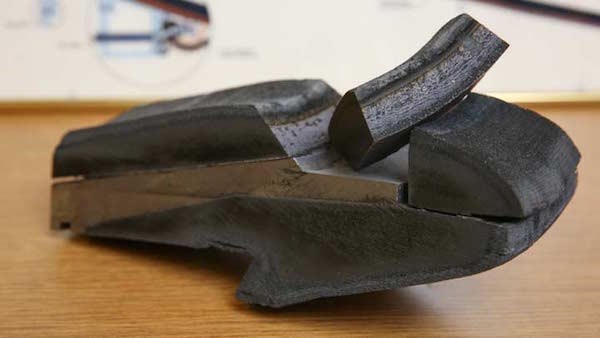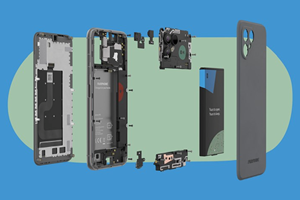Patent issued for carbon fiber used in rocket nozzles
A professor at the University of Alabama in Huntsville developed a new process to make carbon fiber that forms ablative rocket nozzles and heat shields.

A cutaway section of a carbon fiber rocket nozzle from NASA’s Marshall Space Flight Center reveals the layers of material. Photo credit: Michael Mercier/UAH.
I came across a new patent that I thought would be of interest to you all. The process, developed by a University of Alabama in Huntsville (UAH) professor, produces carbon fiber that forms ablative rocket nozzles and heat shields. The university claims that the new process could be of interest to NASA, which has a dwindling stockpile of cellulose rayon fiber that dates back to the late 1990s.
"This is a green process, so it is environmentally clean," says William Kaukler, an associate research professor at UAH’s Rotorcraft Systems Engineering and Simulation Center and a NASA contractor for 35 years in a news release from the university. "We recycle all the byproducts."
Kaukler developed the new ionic process at UAH’s Reliability and Failure Analysis Laboratory with funding from the U.S. Army’s Aviation and Missile Research, Development and Engineering Center (AMRDEC).
"Other people know about using ionic processes to make fibers but they are not making carbon fibers with them," Kaukler says. "The trick was to make the properties of this fiber match the properties of the North American Rayon Corp. (NARC) fiber."
NARC ceased rayon production in the U.S. after it was unable financially to comply with Environmental Protection Agency regulations for the hazardous wastes created.
To form a solid fuel rocket nozzle, layers of carbon fiber fabric made from carbonized rayon are coated with pitch and wound around a mandrel, and then heat-treated to convert the pitch to solid carbon. The resulting nozzle will be a carbon fiber reinforced-carbon composite. A single large solid rocket motor like that used for shuttle boosters can use up to 35 tons of fiber. The rocket nozzles of Army missiles are made from phenolic resin and this same carbon fiber.
"This carbon fiber is not the same fiber that you’d go out and make aircraft or car parts from," says Kaukler. "This is the only way to make the carbon fiber that is suitable for rocket nozzles, is to start with cellulosic fiber." The more common carbon fiber used in structural applications is made from polyacrylonitrile (PAN) and, while stronger, its thermal conductivity is too high.
Heat created from the rocket’s burning fuel slowly burns away the interior of the nozzle in flight.
"That’s why you have to make the fiber out of cellulose, because it has the lowest rate of thermal conductivity of any fiber," Kaukler says. The low conductivity keeps the propellant’s heat in for more propulsion efficiency and it prevents the nozzle from burning away too quickly in flight, with disastrous consequences.
Scaling up the process to manufacturing dimensions could aid NASA as it moves forward with solid rocket motors in its next-generation Space Launch System, and it could prove useful for heat shields used in re-entry to Earth’s atmosphere or on planetary probes designed for landing, Kaukler says.
"It would be useful for any aero-entry onto a planet," he says.

Dr. William Kaukler with a display of the results of his work in his lab at the Reliability and Failure Analysis Laboratory in UAH’s Von Braun Research Hall. Photo credit: Michael Mercier/UAH.
Related Content
Bio-based acrylonitrile for carbon fiber manufacture
The quest for a sustainable source of acrylonitrile for carbon fiber manufacture has made the leap from the lab to the market.
Read MoreComposites end markets: Electronics (2024)
Increasingly, prototype and production-ready smart devices featuring thermoplastic composite cases and other components provide lightweight, optimized sustainable alternatives to metal.
Read MoreNatural fiber composites: Growing to fit sustainability needs
Led by global and industry-wide sustainability goals, commercial interest in flax and hemp fiber-reinforced composites grows into higher-performance, higher-volume applications.
Read MoreNovel composite technology replaces welded joints in tubular structures
The Tree Composites TC-joint replaces traditional welding in jacket foundations for offshore wind turbine generator applications, advancing the world’s quest for fast, sustainable energy deployment.
Read MoreRead Next
All-recycled, needle-punched nonwoven CFRP slashes carbon footprint of Formula 2 seat
Dallara and Tenowo collaborate to produce a race-ready Formula 2 seat using recycled carbon fiber, reducing CO2 emissions by 97.5% compared to virgin materials.
Read MoreVIDEO: High-volume processing for fiberglass components
Cannon Ergos, a company specializing in high-ton presses and equipment for composites fabrication and plastics processing, displayed automotive and industrial components at CAMX 2024.
Read MorePlant tour: Daher Shap’in TechCenter and composites production plant, Saint-Aignan-de-Grandlieu, France
Co-located R&D and production advance OOA thermosets, thermoplastics, welding, recycling and digital technologies for faster processing and certification of lighter, more sustainable composites.
Read More






















